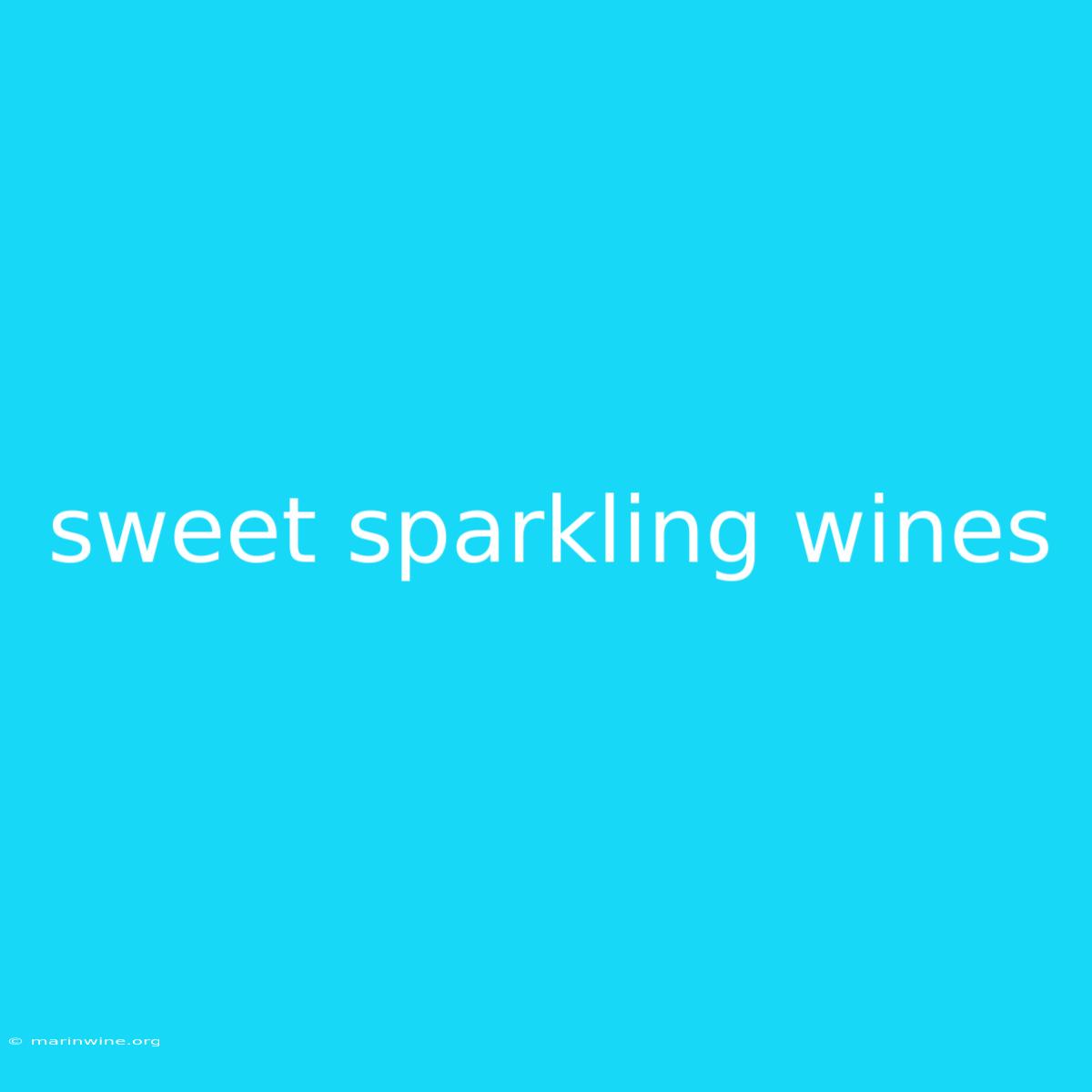Sweet Sparkling Wines: Discover the Bubbly Delights You Never Knew Existed
Have you ever wondered why some sparkling wines are so much sweeter than others? It's all about the sugar content, and this can vary greatly depending on the winemaking process. Today, we're diving into the world of sweet sparkling wines, uncovering the hidden gems and delightful flavors that await your palate.
Why It Matters: Sweet sparkling wines offer a refreshing and approachable alternative to the dryness of traditional champagne. Whether you're a casual wine enthusiast or a seasoned connoisseur, exploring this category expands your bubbly horizons, unveiling a spectrum of aromas and textures you may not have encountered before.
Key Takeaways of Sweet Sparkling Wines:
| Key Takeaway | Description |
|---|---|
| Sweetness | The level of sweetness is determined by the residual sugar content after fermentation. |
| Variety | Sweet sparkling wines are available in various styles, from light and fruity to rich and complex. |
| Food Pairings | Sweet sparkling wines complement desserts, appetizers, spicy dishes, and even light meats. |
Sweet Sparkling Wines: A Journey of Delight
Introduction:
Sweet sparkling wines, often referred to as doux or demi-sec, offer a distinct experience compared to their drier counterparts. Their residual sugar adds a noticeable sweetness, transforming the palate with a delicate balance of acidity and fruitiness.
Key Aspects:
- Sugar Content: The residual sugar in sweet sparkling wines can range from 30 to 50 grams per liter, impacting the overall sweetness profile.
- Fruitiness: Sweet sparkling wines often showcase pronounced fruit flavors, from citrus and berries to tropical notes.
- Acidity: While sweet, these wines still possess a refreshing acidity that balances the sweetness and prevents it from becoming cloying.
Exploring the Connection Between Sugar Content and Flavor:
Sugar content plays a pivotal role in shaping the flavor profile of sweet sparkling wines.
Low residual sugar (30-40 g/l): These wines possess a delicate sweetness, often highlighting fresh fruit flavors like citrus and green apple.
Medium residual sugar (40-50 g/l): These wines display a noticeable sweetness with richer fruit notes like berries and tropical fruits.
Sweet Sparkling Wine Styles:
Moscato d'Asti (Italy): This light, aromatic wine boasts floral notes and low alcohol content, making it a popular choice for aperitifs.
Asti Spumante (Italy): This bubbly, slightly sweet wine offers a fruity and refreshing experience.
Lambrusco (Italy): This sparkling red wine exhibits a range of sweetness levels, from dry to semi-sweet, often showcasing flavors of red berries and cherries.
Brachetto d'Acqui (Italy): This slightly sweet, sparkling red wine offers a delicate aroma of roses and strawberries.
Rosé d'Anjou (France): This French sweet sparkling wine features a delicate pink hue, often showcasing flavors of strawberries and raspberries.
Food Pairings:
Sweet sparkling wines excel at complementing a wide range of culinary delights. Here are some pairings to consider:
- Desserts: Their sweetness pairs perfectly with cakes, pastries, and chocolate desserts.
- Appetizers: Sweet sparkling wines enhance the flavors of savory appetizers like cheese plates and charcuterie boards.
- Spicy Dishes: Their sweetness can balance the heat of spicy foods, creating a harmonious flavor profile.
- Light Meats: Sweet sparkling wines complement light meats like chicken and pork, offering a refreshing contrast.
FAQ:
Q: Are sweet sparkling wines less sophisticated than dry sparkling wines?
A: Absolutely not. Sweet sparkling wines are just as sophisticated and can be just as complex as dry sparkling wines. They simply offer a different flavor profile and are perfect for different occasions.
Q: Can sweet sparkling wines be enjoyed with food?
**A: **Yes, sweet sparkling wines can be enjoyed with food. They complement a wide range of dishes, especially those with sweet or spicy flavors.
Q: What are some good sweet sparkling wines to try?
A: Look for Moscato d'Asti, Asti Spumante, Lambrusco, Brachetto d'Acqui, and Rosé d'Anjou. These wines offer a great starting point for exploring the world of sweet sparkling wines.
Tips for Enjoying Sweet Sparkling Wines:
- Chill them thoroughly: Sweet sparkling wines are best served chilled, enhancing their refreshing qualities.
- Explore a variety of styles: Don't be afraid to experiment and discover new flavors.
- Pair them creatively: Get creative with your food pairings, allowing the sweetness of the wine to enhance the flavors of your dishes.
- Enjoy them in moderation: While sweet sparkling wines are delicious, remember to enjoy them in moderation.
Summary:
Sweet sparkling wines offer a diverse world of flavors and aromas, providing a refreshing and enjoyable experience for any occasion. From light and fruity to rich and complex, these bubbly delights cater to diverse palates. Whether you're seeking a delightful aperitif or a perfect companion for a meal, exploring the realm of sweet sparkling wines promises a journey of discovery and delight.
Closing Message: Step outside your comfort zone and embrace the delightful world of sweet sparkling wines. You may be surprised by the hidden treasures awaiting your palate. From light and fruity Moscato d'Asti to the robust flavors of Lambrusco, there's a sweet sparkling wine out there waiting to be discovered!

